Macroeconomics Assignment: ECO202 - Okun's Law, PAE, and Trade
VerifiedAdded on 2023/06/11
|8
|1114
|141
Homework Assignment
AI Summary
This document presents a comprehensive solution to an ECO202 macroeconomics assignment, addressing key concepts such as Okun's Law, planned aggregate expenditure (PAE), and international trade. The solution begins by applying Okun's Law to calculate missing economic data for the Au...
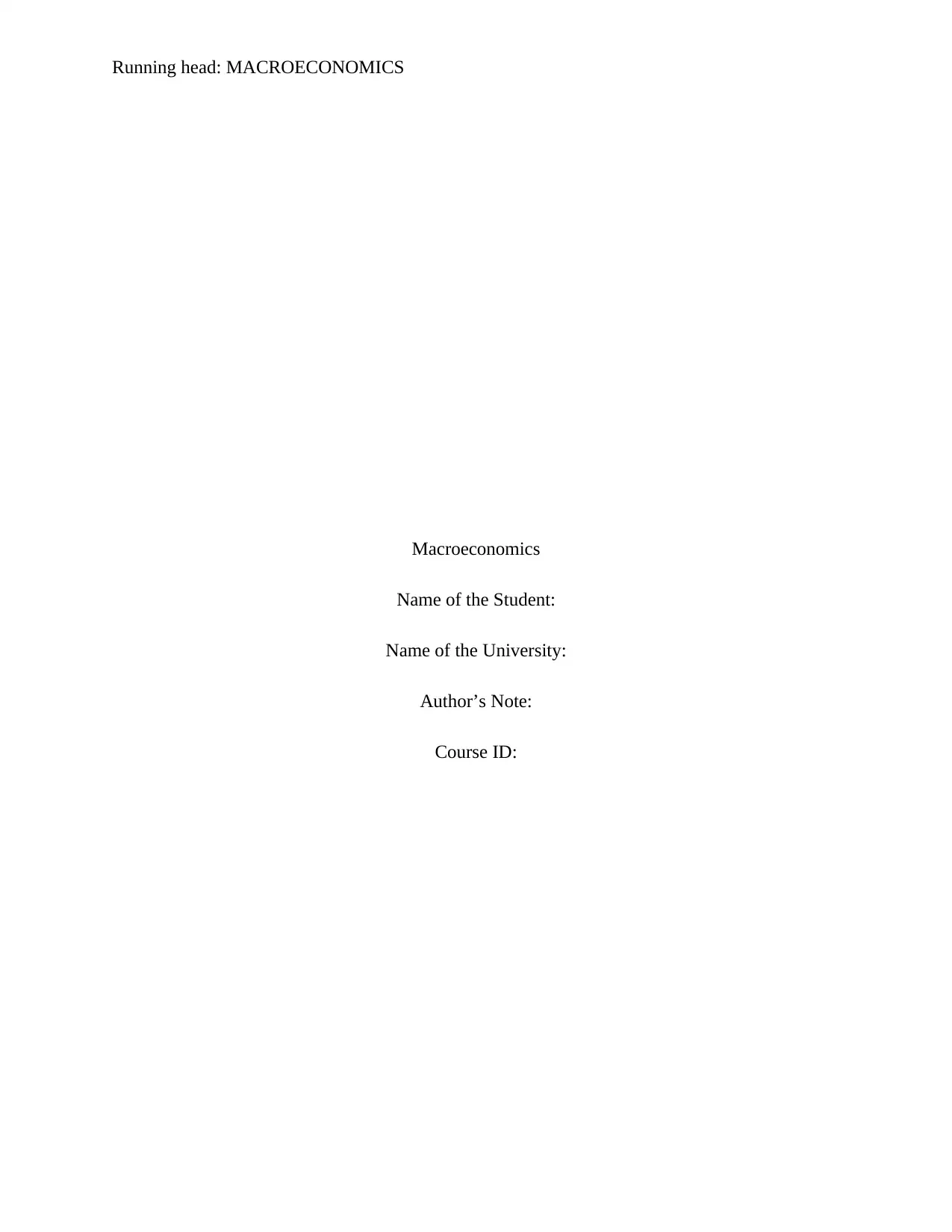
Running head: MACROECONOMICS
Macroeconomics
Name of the Student:
Name of the University:
Author’s Note:
Course ID:
Macroeconomics
Name of the Student:
Name of the University:
Author’s Note:
Course ID:
Paraphrase This Document
Need a fresh take? Get an instant paraphrase of this document with our AI Paraphraser
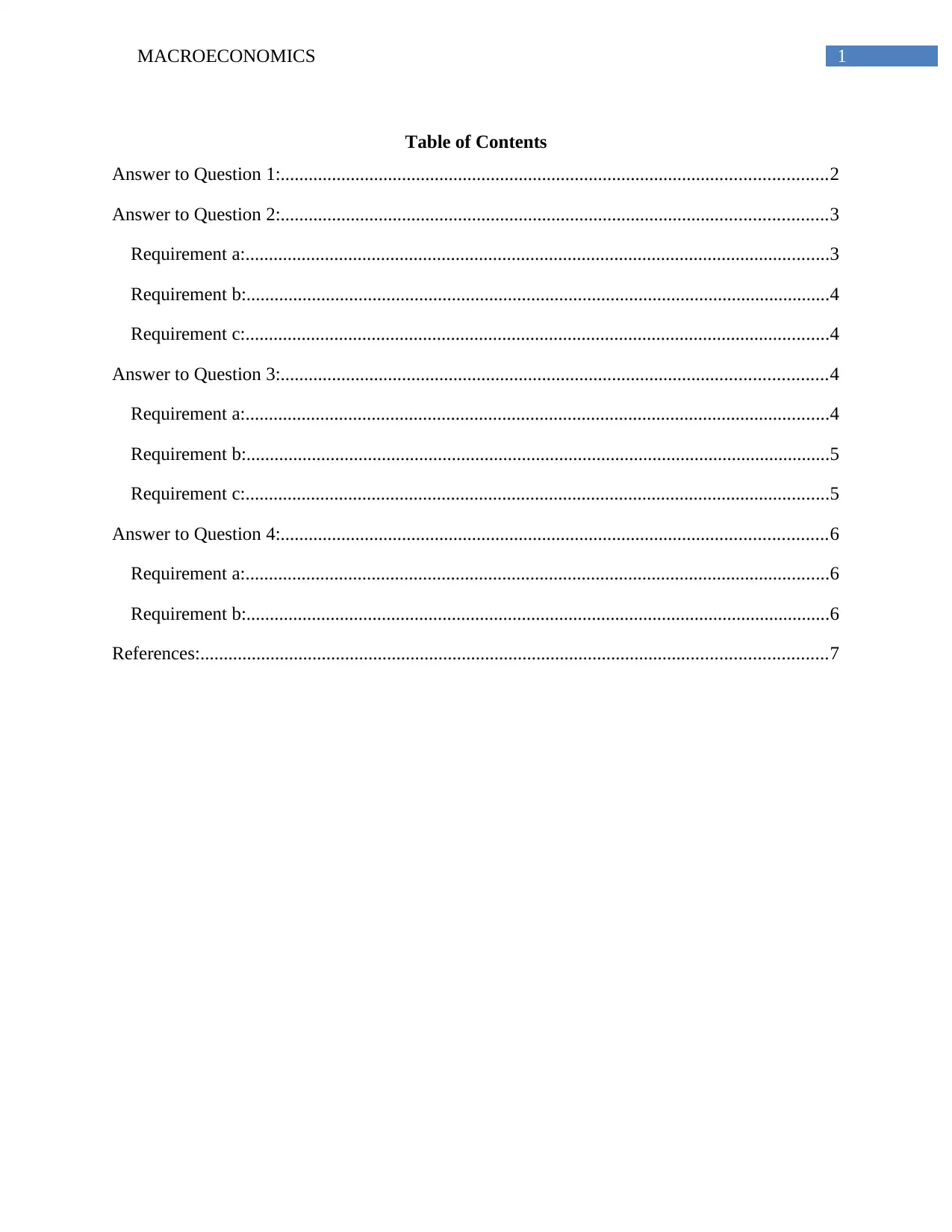
1MACROECONOMICS
Table of Contents
Answer to Question 1:.....................................................................................................................2
Answer to Question 2:.....................................................................................................................3
Requirement a:.............................................................................................................................3
Requirement b:.............................................................................................................................4
Requirement c:.............................................................................................................................4
Answer to Question 3:.....................................................................................................................4
Requirement a:.............................................................................................................................4
Requirement b:.............................................................................................................................5
Requirement c:.............................................................................................................................5
Answer to Question 4:.....................................................................................................................6
Requirement a:.............................................................................................................................6
Requirement b:.............................................................................................................................6
References:......................................................................................................................................7
Table of Contents
Answer to Question 1:.....................................................................................................................2
Answer to Question 2:.....................................................................................................................3
Requirement a:.............................................................................................................................3
Requirement b:.............................................................................................................................4
Requirement c:.............................................................................................................................4
Answer to Question 3:.....................................................................................................................4
Requirement a:.............................................................................................................................4
Requirement b:.............................................................................................................................5
Requirement c:.............................................................................................................................5
Answer to Question 4:.....................................................................................................................6
Requirement a:.............................................................................................................................6
Requirement b:.............................................................................................................................6
References:......................................................................................................................................7
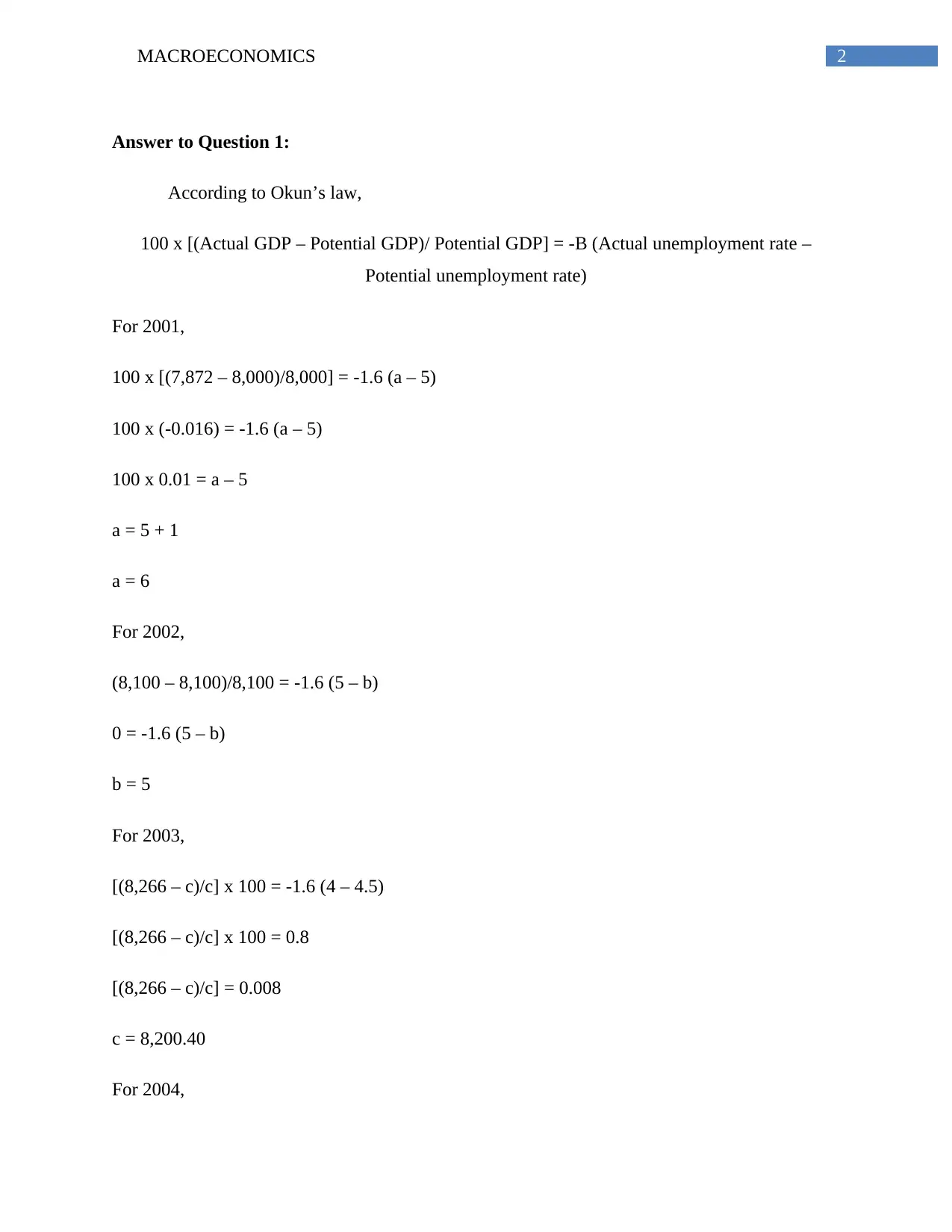
2MACROECONOMICS
Answer to Question 1:
According to Okun’s law,
100 x [(Actual GDP – Potential GDP)/ Potential GDP] = -B (Actual unemployment rate –
Potential unemployment rate)
For 2001,
100 x [(7,872 – 8,000)/8,000] = -1.6 (a – 5)
100 x (-0.016) = -1.6 (a – 5)
100 x 0.01 = a – 5
a = 5 + 1
a = 6
For 2002,
(8,100 – 8,100)/8,100 = -1.6 (5 – b)
0 = -1.6 (5 – b)
b = 5
For 2003,
[(8,266 – c)/c] x 100 = -1.6 (4 – 4.5)
[(8,266 – c)/c] x 100 = 0.8
[(8,266 – c)/c] = 0.008
c = 8,200.40
For 2004,
Answer to Question 1:
According to Okun’s law,
100 x [(Actual GDP – Potential GDP)/ Potential GDP] = -B (Actual unemployment rate –
Potential unemployment rate)
For 2001,
100 x [(7,872 – 8,000)/8,000] = -1.6 (a – 5)
100 x (-0.016) = -1.6 (a – 5)
100 x 0.01 = a – 5
a = 5 + 1
a = 6
For 2002,
(8,100 – 8,100)/8,100 = -1.6 (5 – b)
0 = -1.6 (5 – b)
b = 5
For 2003,
[(8,266 – c)/c] x 100 = -1.6 (4 – 4.5)
[(8,266 – c)/c] x 100 = 0.8
[(8,266 – c)/c] = 0.008
c = 8,200.40
For 2004,
You're viewing a preview
Unlock full access by subscribing today!
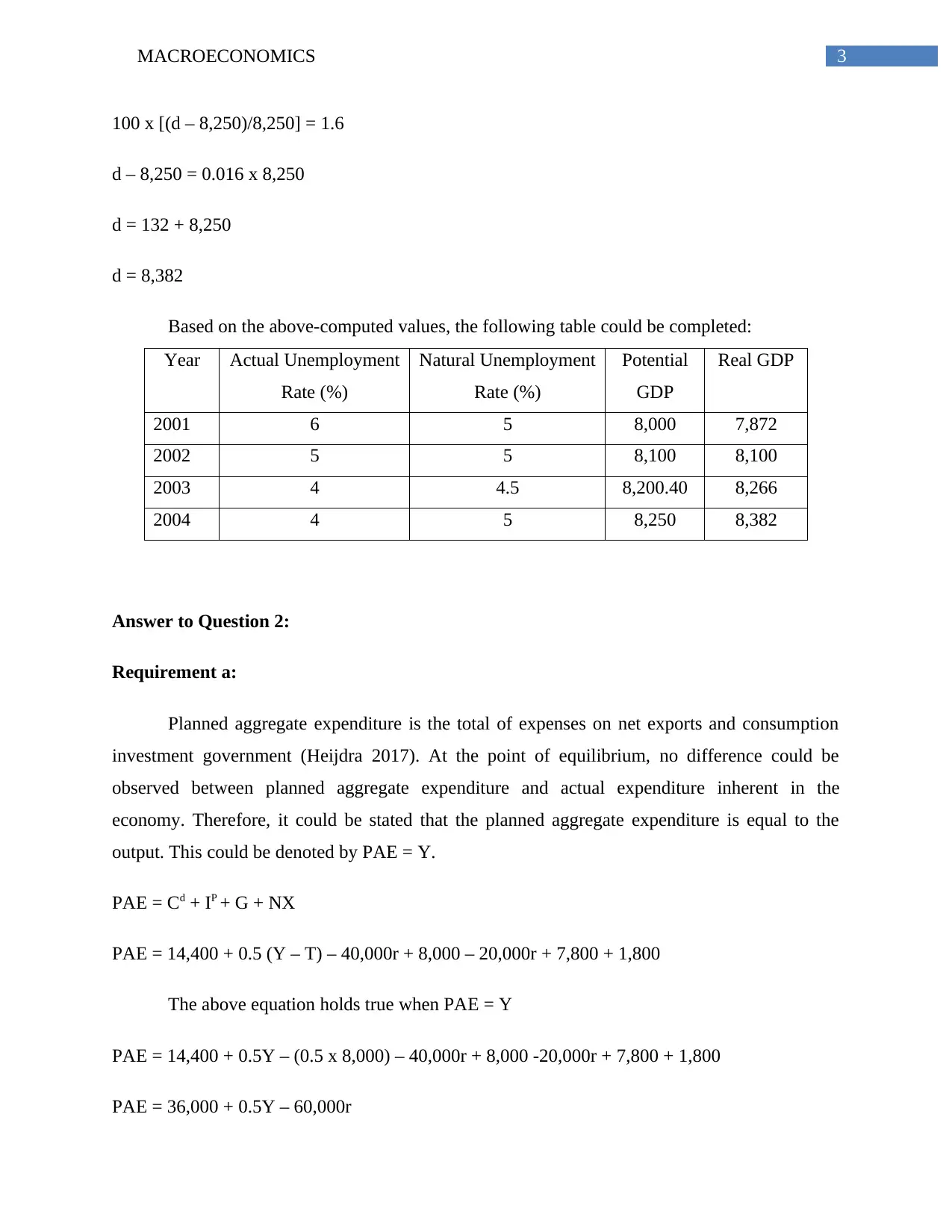
3MACROECONOMICS
100 x [(d – 8,250)/8,250] = 1.6
d – 8,250 = 0.016 x 8,250
d = 132 + 8,250
d = 8,382
Based on the above-computed values, the following table could be completed:
Year Actual Unemployment
Rate (%)
Natural Unemployment
Rate (%)
Potential
GDP
Real GDP
2001 6 5 8,000 7,872
2002 5 5 8,100 8,100
2003 4 4.5 8,200.40 8,266
2004 4 5 8,250 8,382
Answer to Question 2:
Requirement a:
Planned aggregate expenditure is the total of expenses on net exports and consumption
investment government (Heijdra 2017). At the point of equilibrium, no difference could be
observed between planned aggregate expenditure and actual expenditure inherent in the
economy. Therefore, it could be stated that the planned aggregate expenditure is equal to the
output. This could be denoted by PAE = Y.
PAE = Cd + IP + G + NX
PAE = 14,400 + 0.5 (Y – T) – 40,000r + 8,000 – 20,000r + 7,800 + 1,800
The above equation holds true when PAE = Y
PAE = 14,400 + 0.5Y – (0.5 x 8,000) – 40,000r + 8,000 -20,000r + 7,800 + 1,800
PAE = 36,000 + 0.5Y – 60,000r
100 x [(d – 8,250)/8,250] = 1.6
d – 8,250 = 0.016 x 8,250
d = 132 + 8,250
d = 8,382
Based on the above-computed values, the following table could be completed:
Year Actual Unemployment
Rate (%)
Natural Unemployment
Rate (%)
Potential
GDP
Real GDP
2001 6 5 8,000 7,872
2002 5 5 8,100 8,100
2003 4 4.5 8,200.40 8,266
2004 4 5 8,250 8,382
Answer to Question 2:
Requirement a:
Planned aggregate expenditure is the total of expenses on net exports and consumption
investment government (Heijdra 2017). At the point of equilibrium, no difference could be
observed between planned aggregate expenditure and actual expenditure inherent in the
economy. Therefore, it could be stated that the planned aggregate expenditure is equal to the
output. This could be denoted by PAE = Y.
PAE = Cd + IP + G + NX
PAE = 14,400 + 0.5 (Y – T) – 40,000r + 8,000 – 20,000r + 7,800 + 1,800
The above equation holds true when PAE = Y
PAE = 14,400 + 0.5Y – (0.5 x 8,000) – 40,000r + 8,000 -20,000r + 7,800 + 1,800
PAE = 36,000 + 0.5Y – 60,000r
Paraphrase This Document
Need a fresh take? Get an instant paraphrase of this document with our AI Paraphraser
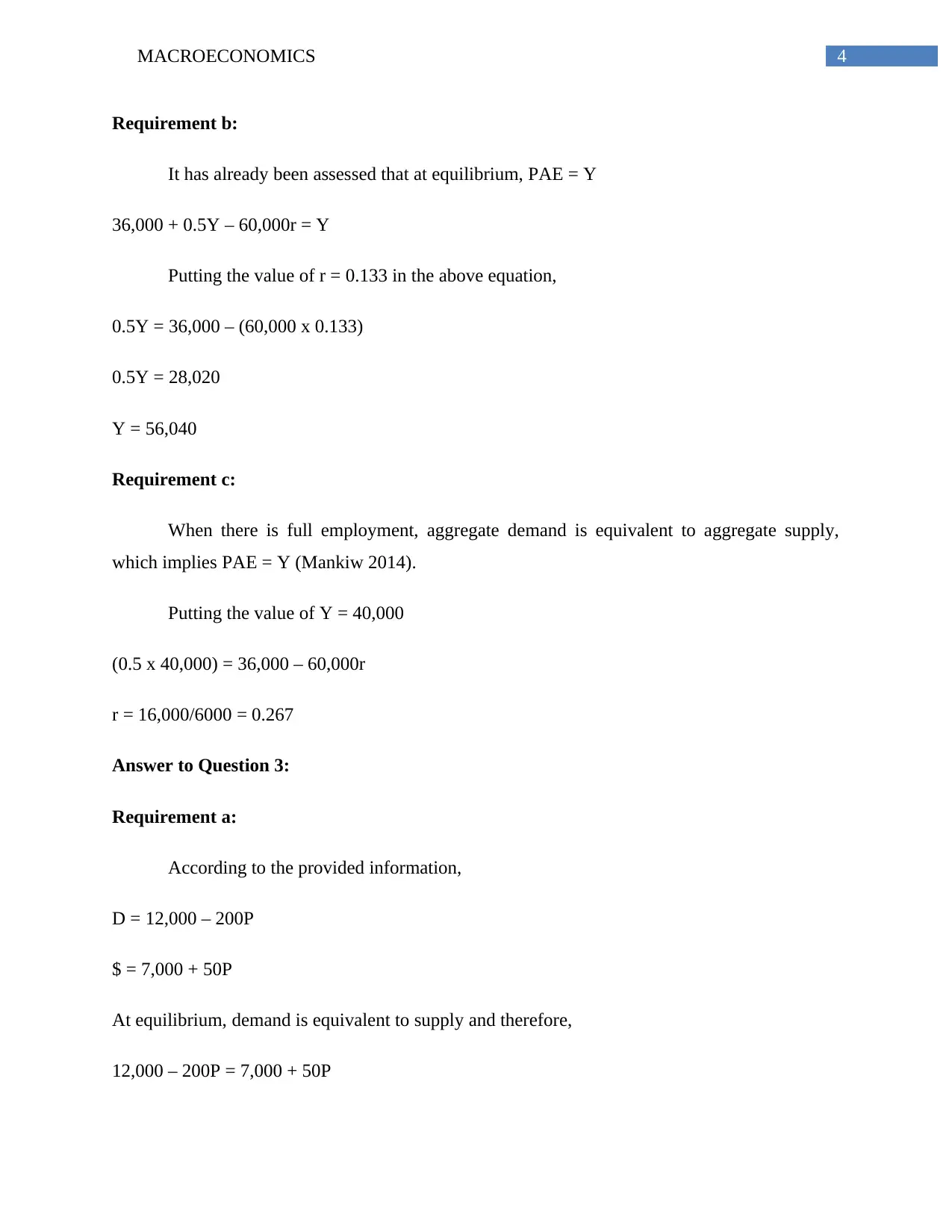
4MACROECONOMICS
Requirement b:
It has already been assessed that at equilibrium, PAE = Y
36,000 + 0.5Y – 60,000r = Y
Putting the value of r = 0.133 in the above equation,
0.5Y = 36,000 – (60,000 x 0.133)
0.5Y = 28,020
Y = 56,040
Requirement c:
When there is full employment, aggregate demand is equivalent to aggregate supply,
which implies PAE = Y (Mankiw 2014).
Putting the value of Y = 40,000
(0.5 x 40,000) = 36,000 – 60,000r
r = 16,000/6000 = 0.267
Answer to Question 3:
Requirement a:
According to the provided information,
D = 12,000 – 200P
$ = 7,000 + 50P
At equilibrium, demand is equivalent to supply and therefore,
12,000 – 200P = 7,000 + 50P
Requirement b:
It has already been assessed that at equilibrium, PAE = Y
36,000 + 0.5Y – 60,000r = Y
Putting the value of r = 0.133 in the above equation,
0.5Y = 36,000 – (60,000 x 0.133)
0.5Y = 28,020
Y = 56,040
Requirement c:
When there is full employment, aggregate demand is equivalent to aggregate supply,
which implies PAE = Y (Mankiw 2014).
Putting the value of Y = 40,000
(0.5 x 40,000) = 36,000 – 60,000r
r = 16,000/6000 = 0.267
Answer to Question 3:
Requirement a:
According to the provided information,
D = 12,000 – 200P
$ = 7,000 + 50P
At equilibrium, demand is equivalent to supply and therefore,
12,000 – 200P = 7,000 + 50P
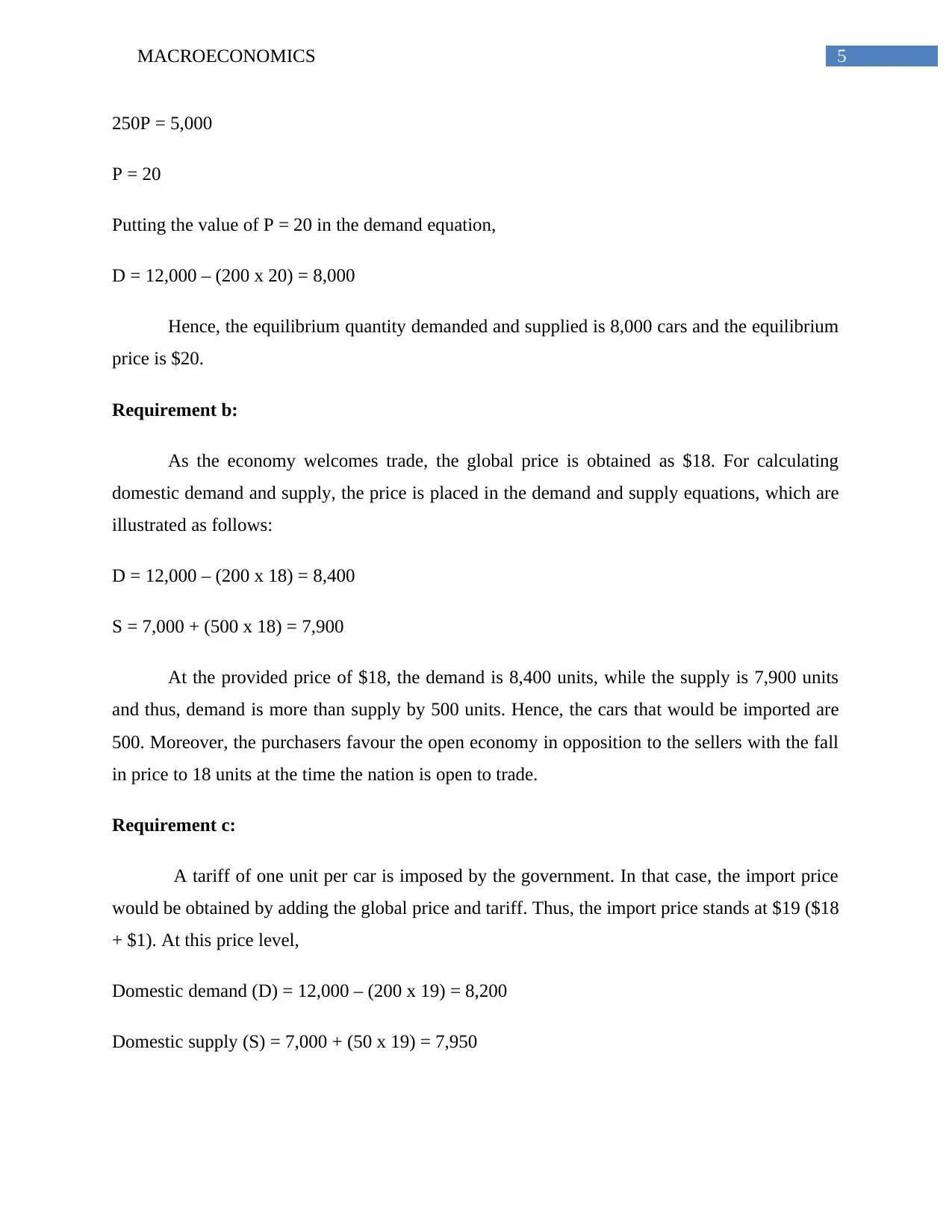
5MACROECONOMICS
250P = 5,000
P = 20
Putting the value of P = 20 in the demand equation,
D = 12,000 – (200 x 20) = 8,000
Hence, the equilibrium quantity demanded and supplied is 8,000 cars and the equilibrium
price is $20.
Requirement b:
As the economy welcomes trade, the global price is obtained as $18. For calculating
domestic demand and supply, the price is placed in the demand and supply equations, which are
illustrated as follows:
D = 12,000 – (200 x 18) = 8,400
S = 7,000 + (500 x 18) = 7,900
At the provided price of $18, the demand is 8,400 units, while the supply is 7,900 units
and thus, demand is more than supply by 500 units. Hence, the cars that would be imported are
500. Moreover, the purchasers favour the open economy in opposition to the sellers with the fall
in price to 18 units at the time the nation is open to trade.
Requirement c:
A tariff of one unit per car is imposed by the government. In that case, the import price
would be obtained by adding the global price and tariff. Thus, the import price stands at $19 ($18
+ $1). At this price level,
Domestic demand (D) = 12,000 – (200 x 19) = 8,200
Domestic supply (S) = 7,000 + (50 x 19) = 7,950
250P = 5,000
P = 20
Putting the value of P = 20 in the demand equation,
D = 12,000 – (200 x 20) = 8,000
Hence, the equilibrium quantity demanded and supplied is 8,000 cars and the equilibrium
price is $20.
Requirement b:
As the economy welcomes trade, the global price is obtained as $18. For calculating
domestic demand and supply, the price is placed in the demand and supply equations, which are
illustrated as follows:
D = 12,000 – (200 x 18) = 8,400
S = 7,000 + (500 x 18) = 7,900
At the provided price of $18, the demand is 8,400 units, while the supply is 7,900 units
and thus, demand is more than supply by 500 units. Hence, the cars that would be imported are
500. Moreover, the purchasers favour the open economy in opposition to the sellers with the fall
in price to 18 units at the time the nation is open to trade.
Requirement c:
A tariff of one unit per car is imposed by the government. In that case, the import price
would be obtained by adding the global price and tariff. Thus, the import price stands at $19 ($18
+ $1). At this price level,
Domestic demand (D) = 12,000 – (200 x 19) = 8,200
Domestic supply (S) = 7,000 + (50 x 19) = 7,950
You're viewing a preview
Unlock full access by subscribing today!
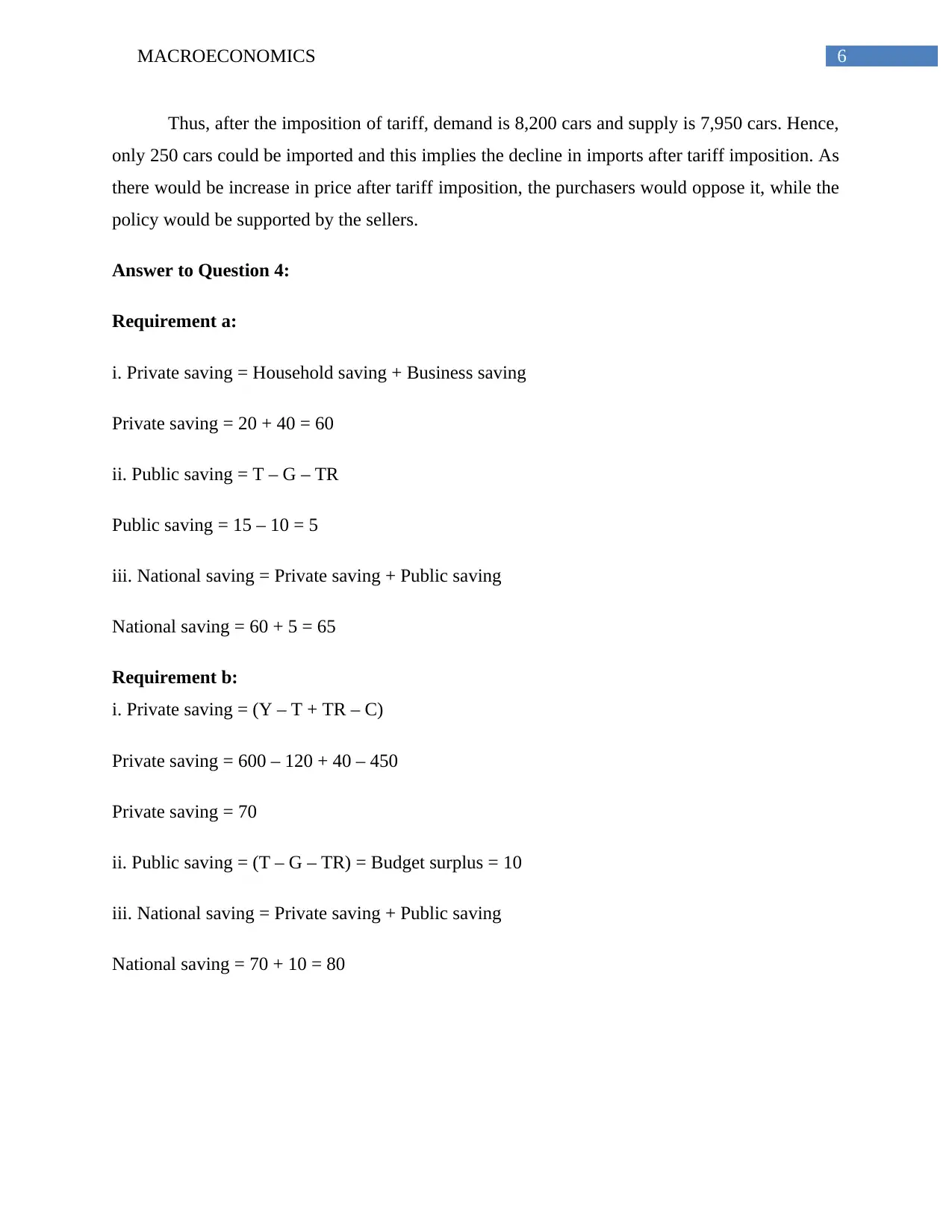
6MACROECONOMICS
Thus, after the imposition of tariff, demand is 8,200 cars and supply is 7,950 cars. Hence,
only 250 cars could be imported and this implies the decline in imports after tariff imposition. As
there would be increase in price after tariff imposition, the purchasers would oppose it, while the
policy would be supported by the sellers.
Answer to Question 4:
Requirement a:
i. Private saving = Household saving + Business saving
Private saving = 20 + 40 = 60
ii. Public saving = T – G – TR
Public saving = 15 – 10 = 5
iii. National saving = Private saving + Public saving
National saving = 60 + 5 = 65
Requirement b:
i. Private saving = (Y – T + TR – C)
Private saving = 600 – 120 + 40 – 450
Private saving = 70
ii. Public saving = (T – G – TR) = Budget surplus = 10
iii. National saving = Private saving + Public saving
National saving = 70 + 10 = 80
Thus, after the imposition of tariff, demand is 8,200 cars and supply is 7,950 cars. Hence,
only 250 cars could be imported and this implies the decline in imports after tariff imposition. As
there would be increase in price after tariff imposition, the purchasers would oppose it, while the
policy would be supported by the sellers.
Answer to Question 4:
Requirement a:
i. Private saving = Household saving + Business saving
Private saving = 20 + 40 = 60
ii. Public saving = T – G – TR
Public saving = 15 – 10 = 5
iii. National saving = Private saving + Public saving
National saving = 60 + 5 = 65
Requirement b:
i. Private saving = (Y – T + TR – C)
Private saving = 600 – 120 + 40 – 450
Private saving = 70
ii. Public saving = (T – G – TR) = Budget surplus = 10
iii. National saving = Private saving + Public saving
National saving = 70 + 10 = 80
Paraphrase This Document
Need a fresh take? Get an instant paraphrase of this document with our AI Paraphraser
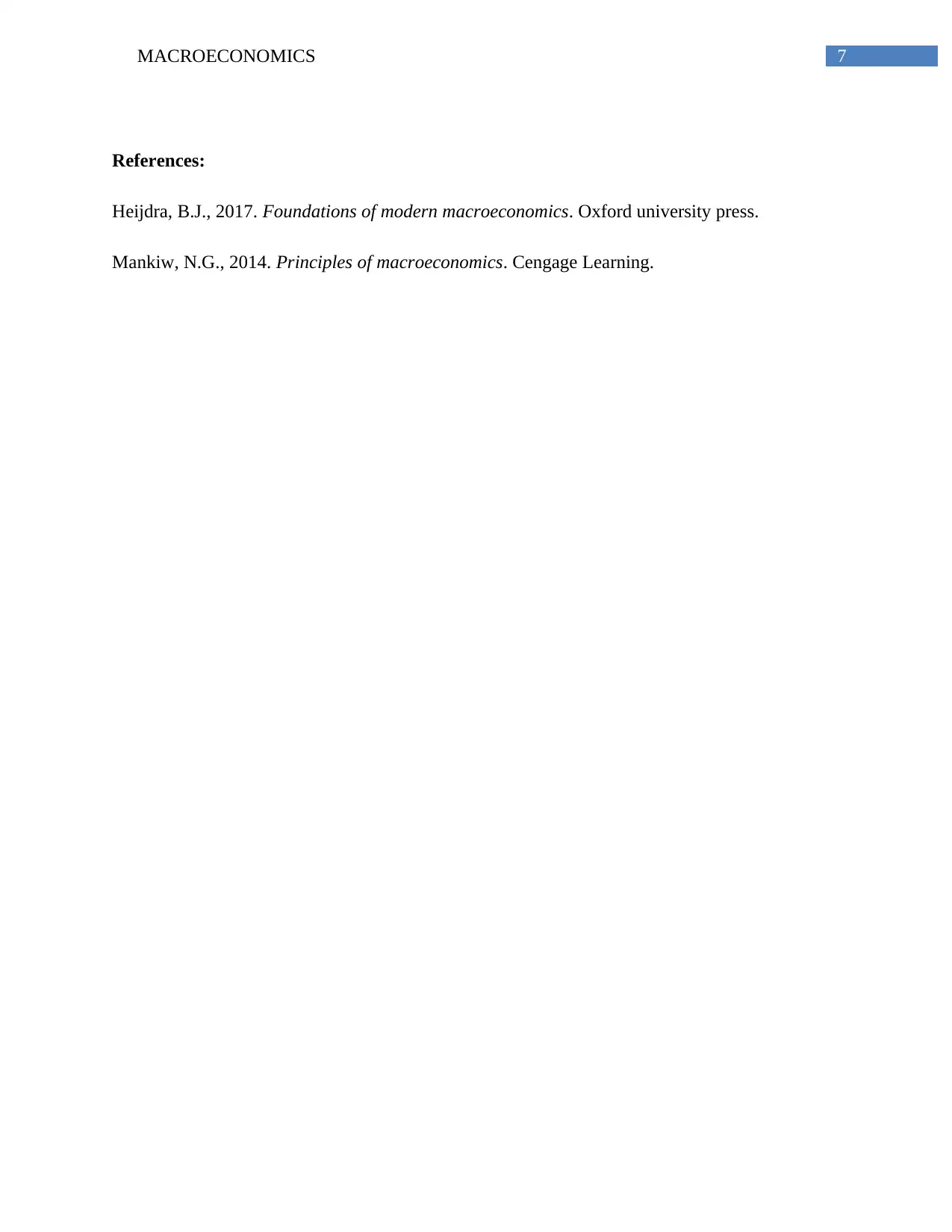
7MACROECONOMICS
References:
Heijdra, B.J., 2017. Foundations of modern macroeconomics. Oxford university press.
Mankiw, N.G., 2014. Principles of macroeconomics. Cengage Learning.
References:
Heijdra, B.J., 2017. Foundations of modern macroeconomics. Oxford university press.
Mankiw, N.G., 2014. Principles of macroeconomics. Cengage Learning.
1 out of 8
Related Documents
Your All-in-One AI-Powered Toolkit for Academic Success.
+13062052269
info@desklib.com
Available 24*7 on WhatsApp / Email
![[object Object]](/_next/static/media/star-bottom.7253800d.svg)
Unlock your academic potential
© 2024 | Zucol Services PVT LTD | All rights reserved.



